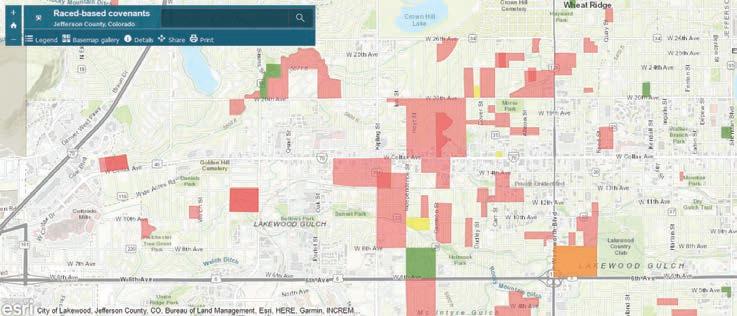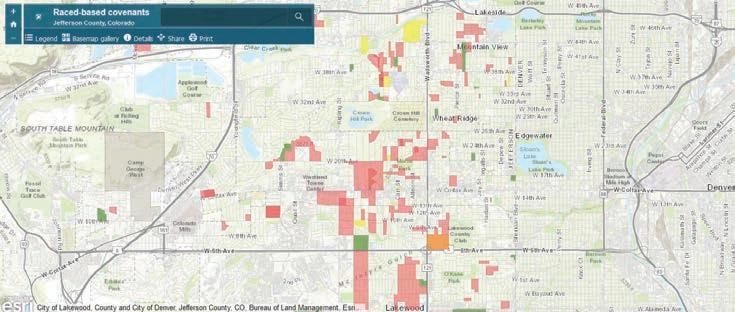
6 minute read
A Look at the Suburbs
Map experts
BY ELLIS ARNOLD EARNOLD@COLORADOCOMMUNITYMEDIA.COM

In 1967, Black Americans were mired in “the long, hot summer.” Frustrations over poverty, unemployment, discrimination and myriad other issues spilled into the streets, leading to clashes with police and arrests in many places, including Denver. e widespread tensions over race left President Lyndon B. Johnson searching for answers.
So, he issued an executive order for a report that would detail what caused the chaos. He wanted it to answer a crucial question: How can the country prevent more unrest in the future?
When the report arrived seven months later, it laid out hundreds of pages of analysis and recommendations for improving race relations in America.
But its message was best summed up in a sentence:
“To continue present policies is to make permanent the division of our country into two societies: one, largely Negro and poor, located in the central cities: the other, pre-
A much di erent than how my parents thought of it,” Aldersea said. “Today, it’s more based on what can be accomplished. It’s not shooting for the stars anymore.”

Aldersea’s personal de nition of the American dream includes a ful lling career, opportunities to be part of a community that one is able to give back to and the freedom to pursue personal interests. She believes housing should be attainable for everyone, but doesn’t think it de nes success or happiness.
Aldersea doesn’t envision ever becoming a homeowner. One reason is that she wants to be able to relocate as she pursues her career goals. Another is that she wants to travel and pay o student loans.
“I don’t think my wage or salary will ever help me a ord a house or mortgage,” Aldersea said. “A house would not be the only thing I’d have to focus on nancially.” dominantly White and a uent, located in the suburbs and in outlying areas.”
Time will tell whether homeownership will eventually become more important to younger Americans. According to Bankrate, the pull to own a home remains strong. Fifty-nine percent of Gen Z members want to own a home as a life goal, second only to having a successful career (60%).
For other generations, homeownership remains the top life goal and the likelihood of that increases with age. Eighty-seven percent of older adults, aged 68 and up, cite homeownership as integral to the American dream.
In other words, the issue of where people can live was at the heart of the report. It all ties into the American dream, the idea of a family owning a home, building wealth as that home increases in value over time and being able to live in whatever neighborhood a family can a ord without fear of discrimination.
Yet more than half a century later, that divide between Black and White residents continues to complicate the dream in many parts of America, including the suburban towns and cities that surround Denver. e divide is less stark and less known than it was in 1967, but its legacy is still alive in the metro area, where the Black population tends to live in Denver or Aurora, numbering in the tens of thousands in each city.
Elsewhere, Black residents number in the hundreds or just a few thousand while White residents make up strong majorities. White residents are 78% of the population in Arvada and 1% are Black. White residents are 80% of the population in Littleton and 2% are Black. White residents are 82% of the population in Castle Rock and less than 1% are Black.


So, why do the metro area’s com- munities look the way they do? e answer isn’t completely clear, but two map experts have delved into local property records, uncovering data that could help start to answer that question. ey’re trying to discover what many have either forgotten or swept under the rug about parts of the metro area — or simply never knew. ey’re digging in at the neighborhood level, looking for words in property documents — called “racially restrictive covenants” — that excluded people from housing by race. ey’re looking to discern the legacies that still echo in communities today.

Golden, took inspiration from the “Mapping Prejudice” project, an effort at the University of Minnesota to identify and map racial covenants.
It wasn’t just developers who pushed such language, iry said.
Christopher iry, a map librarian at Colorado School of Mines in Golden, is one of the diggers. Discovering the covenants in Je erson County shocked him.
“ at blew me away that this rural county at the time would have them,” iry said. “As I tell people, ‘Yeah, the suburbs of Birmingham, Alabama, sure. But Je erson County? Come on.’”
‘Only persons of the Caucasian race’ iry, a longtime resident of



FROM Memory 303-566-4100 obituaries@coloradocommunitymedia.com Self placement available online at CommerceCitySentinel.com iry has examined about 1,000 Je erson County documents and found nearly 200 had some kind of race-based stipulation. He looked at documents from the 1860s to 1950, though most of them were from the 1910s to 1950.
He jumped into his work after the killing of George Floyd by a Minneapolis police o cer. e mapping is a tedious task of sifting through mostly mundane, uncontroversial rules, like how many feet a house must sit away from the road or bans on billboards in front of homes.
Speci cally, he has pored over “plats,” or plans for new neighborhoods. e plat for one neighborhood — Cole Village, located along Colfax Avenue near Kipling Street in what’s now Lakewood — had this to say:
“Only persons of the Caucasian race shall use or occupy any building or any lot. is covenant shall not prevent use or occupancy by domestic servants of a di erent race.” e document was registered with the county in 1945. at type of racebased language is now unenforceable but remains on o cial plats, property deeds and other documents, according to iry.
Local elected and appointed ofcials of the government of Je erson County signed the documents, iry added.
He singled out some other examples:
• “Ownership in this subdivision shall be restricted to members of the Caucasian race,” says a planning document for Sunshine Park in Golden at Sunshine and High parkways, dated 1944.
• “Stipulate that no lot at any time shall be occupied or owned by any person or persons not of the Caucasian races. However, this provision shall not prohibit the employment of persons of other races by the occupants,” says the plan for Green Acres along 6th Avenue in what’s now Lakewood, dated 1939.
• “No (area) shall at any time be occupied or owned by any person or persons of other than the Caucasian race, however, this shall not prohibit the employment of persons of other races on the premises by the occupants,” says the plan for Happy Valley Acres in the Golden area at South Golden Road and Orion Street, dated 1939.
• “ e said (land) shall (be) used for no other purpose than for the building and maintaining thereon and the occupancy thereof of private residences by Caucasians, and the erection of necessary outbuildings,” says a planning document for part of the Indian Hills area, dated 1923. iry has used his ndings to make a map of the parts of Je erson County where race-based rules were baked into the original plans of the housing developments.
Many are concentrated in what are now the Wheat Ridge and Lakewood areas, with a handful dotting the Golden and Arvada region. Others sit in the Evergreen and Indian Hills areas.
It’s not yet a complete picture.
SUBURBS To see more of our housing series iry is wary that he may have missed pieces. ough the map is a work in progress, it already has him wondering how the covenants still in uence lives today. visit: ColoradoCommunityMedia.com
Beyond that, what can be done to right past wrongs.

WHITE



Barbara Marie White
December 12, 1935 - January 1, 2023
She truly was one of a kind and was always there for support. She continuously supported her husband, children, and grandchildren in their various interests.
Barbara was a 10-year member of 4-H, where she developed her love for animals. She showed cattle at the National Western Stock show in 1949. She was a proud member and past president of the Social Order of the Beauceant Organization which provided entertainment and hospitality for the Knights Templar, while also participating in many other philanthropic endeavors.
Barbara met the love of her life, James White, while in high school. ey were married in 1955. e couple brie y lived in Florida while Jim was in the Military. In 1957 they moved to their home in Brighton, CO to farm, ranch, and dairy. e sweethearts had three children: Larry in 1957, Alan in 1959, and Terri in 1962.
If you knew Barbara, you know she loved to share her passions for gardening, cooking, sewing, canning, and raising animals especially with her children and grandchildren. Barbara loved her family deeply and welcomed everyone. Her home was one where you could always count on cherished family meals, stories, lots of laughs, hugs and her signature- “love you sugar.”
Barbara loved doing things with her family, including going on many traveling adventures. She and Jim bowled with the Wednesday NightBombers for 50 years. Barbara was a very loving wife, mother, grandmother and great grandmother.
Barbara is proceeded in death by her father, mother, three sisters, and husband Jim (2015).
She is survived by her children; Larry (Diane) White, Alan (Lela) White, Terri (Chip) Roberts, 8 grandchildren; Mike (Missy) White, Don White, Levi White, Eric (Hadley) White, Darby Barraza, Nala White, Paige (Taylor) Burkum, Kyla Roberts, 10 great grandchildren and brother-in-law Harlow Leeper. ey will always remember her kindness, generosity, and loving spirit.




